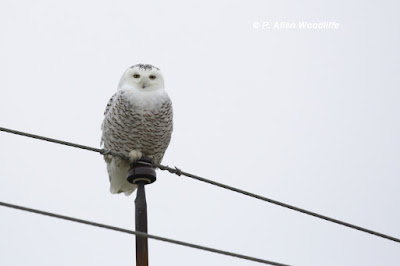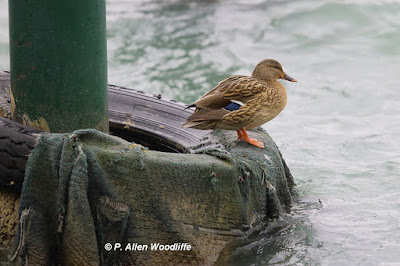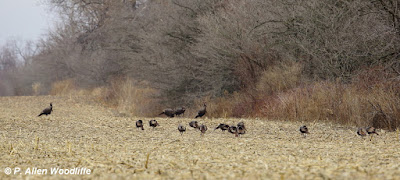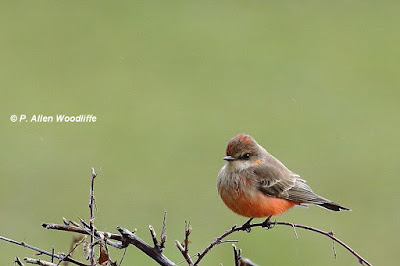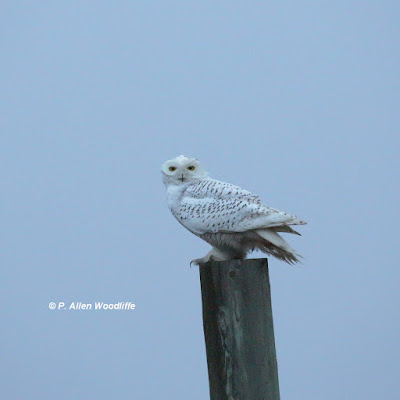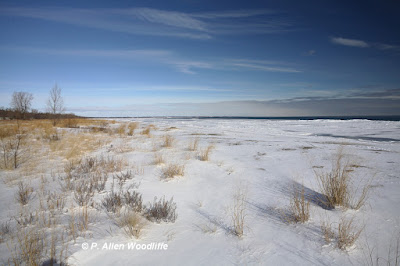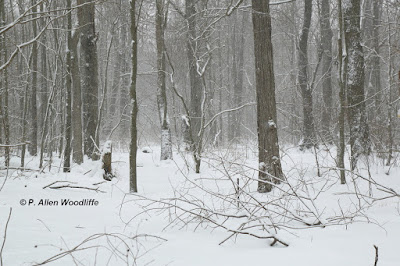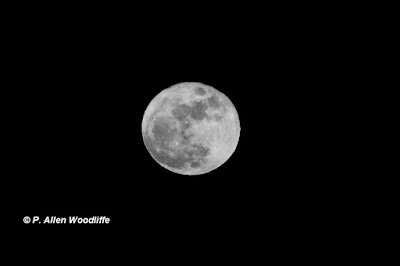The Blenheim/Rondeau Christmas Bird Count was held yesterday, Dec 20. This has been a long tradition here, with the first one occurring in 1939, making this one the 76th count. The database is enormous, not surprisingly, What helps is that for the last 40 or so years, this count has been near or at the top of all Ontario CBCs in terms of species diversity. The cumulative list up until this year stands at an amazing 189 species, including 3 that have only been seen during the count week but not on the count day.
Some species are almost a guarantee. In spite of Bald Eagles being an endangered species for much of the time since 1939, we have only missed recording them on two occasions.

We have endured lots of weather diversity. I have been on this count for 45 years. Some years are windy, including some with sustained 50 km/h winds (and gusts well above that). Some years were so rainy that using binoculars was next to hopeless unless you could use them from inside a sheltered area. Some years were so foggy that you could hear Mallards on Rondeau Bay, but couldn't see them to find out what other species were with them. Some years were so snowy that visibility was difficult, and one could hardly even exit the park to go to the compilation. Some years were bitter cold with wind chills well below -25C, and other years were so mild that I have used a canoe in the marsh on a couple of occasions. Some years it is mild enough that there are even frogs, snakes and turtles out and even bats flying around! For some reason the Eastern Garter Snake in this next image was out on Tuesday, when it was 6C but overcast and with a cold, light drizzle falling.

The 2015 count was relatively benign in terms of weather severity. Cloudy bright conditions are great. The eventual brisk S-SW wind of 35-55+ km/h wasn't so great, especially if one was in an exposed area, which I was as my territory is the most exposed of the entire count circle.
For approximately the last 30 years, my territory has been the South Beach of Rondeau all the way to Erieau and back, and then the south end of the Marsh Road. Both of these areas are quite exposed, and requires a lot of walking on various surfaces. Typically it results in at least 15-18 km of walking, carrying a bunch of equipment (tripod, scope, binoculars, snacks, etc while dressed in winter attire). For some reason it seems to be more challenging to cover this area than it did 30 years ago.
The early morning hours were clear, with very little wind, which is normally ideal conditions for calling for owls. Just as I got out of the car at my first stopping point to call for owls,I heard a gentle ruckus in the trees. When I looked over and up, I noted 14 Wild Turkeys silhouetted against the sky. It always seems a bit odd to see such large and ungainly birds roosting so high up on bare branches, but I am sure they feel safer there than on the ground where a prowling coyote or fox might disrupt their sleep. After a few moments some, and then the rest, decided to complete their early morning roosting activity a little farther away from this human intruder.
For some reason, the owls weren't as vocal this year as they sometimes are, and only two Eastern Screech Owls responded. As daybreak approached, I headed to the very south end of Rondeau Road/South Point Trail to begin the trek out along the South Beach. The first few hundred metres are challenging to get through, as the heavy winds and waves of these past few weeks have caused lots of tree fall, and the shoreline is littered with downed trees. The southerly winds today were the source of light wave action to begin with, so walking along the shoreline here was not possible. The only way to access my territory was to make my way around or through the downed trees, etc., which at times required one to crawl on hands and knees. But it was worth it.
The sun was pleasingly bright and the southerly winds fairly light first thing, although that would deteriorate after an hour or so.
The overnight cold made the wet sand quite firm to walk on, fortunately. As the wind and waves increased on the lake side, I spent more time along the lightly sheltered marsh and bay side of the sand barrier beach. As it turned out, some of the wave action of the past few weeks had washed a large amount of sand over and created some nice sandy conditions along the bay/marsh edge.
With all of this exposed sandy shoreline with some detritus along the edge, as well as the unseasonably mild weather, surely it would be good for shorebirds, right? Over the years I've had about 10 species of shorebird in my territory. But it wasn't to be this year.....not a single one. Perhaps there was too much habitat for the few shorebirds that were likely still around somewhere.
There was lots of waterfowl diversity waiting for me. I recorded 19 species altogether, including only the third Eurasian Wigeon ever on this count. At least one male had been seen fairly regularly on the southern part of Rondeau Bay over the last couple of months, so it wasn't altogether a surprise. And it was a good year for Hooded Mergansers, one of my favourite ducks. The day before the count I had at least 60 at Erieau. Finding 11 at the south end of Rondeau Bay during the count was a nice treat.
 |
| About 20 Hoodies |
 |
| Male Hooded Merganser |
 |
| Female Hooded Merganser |
The most abundant species of duck was Canvasback, with about 425 within view from the South Beach. Waterfowl hunters indicated that there had been a rather large number arrive in the previous few days. I expect there were more along the edge of the marsh that never got counted.
Mallards were the next most abundant duck, not surprisingly. I counted 373, not including this next one.
 |
| Anas plasticus |
If it seems a bit shiny, that is because it is plastic! I guess this one got away from some hunters, as I found it along the bay shoreline.
I had only a single American Coot. It had been resting in some vegetation along the shoreline, but took off quickly as I approached. It seemed to be fine. I'm not sure what it was doing here all by itself, as ~4400 of its relatives were hanging out near Erieau. This next image is a portion of a very jam-packed group of coot I observed there on Saturday. Try counting them!
After completing my route along the South Beach, I headed for the Marsh Trail. There were ducks and gulls along the ice well out from the shoreline of the marsh. But the trail itself was almost entirely devoid of birds. I had a grand total of 9 American Tree Sparrows and one Swamp Sparrow for my entire almost 6 kilometre walk! Undoubtedly there were numerous Swamp Sparrows and others in the marsh, but I couldn't hear them chipping and they weren't responding to my 'spishing', so they probably couldn't hear me any better in all that wind.
I decided to try some woodland area at the north end of the park. Pileated Woodpeckers are permanent residents of Rondeau, but they can be notoriously difficult to find when you need them to fill in a spot on a checklist. So I worked my way along the north end of Rondeau Road, where I had seen a Pileated a few days earlier. It was a long shot, I knew, but maybe I would get lucky. At least I might find some other woodland species to add to my list.
On the way over, I came across intrepid birder Blake "Boatmann" Mann, complete with the requisite binoculars and camera gear, on the prowl for something new. We shared greetings and notes before continuing on our separate ways.
As it turned out, small birds weren't much better in woodland areas than they were elsewhere. The road and woodland edges were very quiet. There has been a deer herd reduction program on in the park in recent weeks, and I went in to one of the baiting stations to see if there was anything coming in to bits of bait remaining on the ground. A Downy Woodpecker was there, and didn't seem interested in leaving this small stash of food, so after a couple of shots, I left it to its meal.
Right near by was a large Silver Maple. Regular readers will be aware of my interest in big trees, and I had measured this one a couple of weeks ago. It is 122 cm in diameter....certainly not the largest Silver Maple I have come across, but an impressive specimen nonetheless. For a Silver Maple it was in very good shape. Most of them when they get anywhere close to this size, show major damage such as a broken top or lost or broken limbs. Not this one.
I walked by the remains of an Acadian Flycatcher nest. Even when it is in use, it looks flimsy, but the elements of these past few months have caused significant damage. By the time some snow settles in it, or if there is much more rain or wind, it will be completely gone, I am sure.
I did come across a Hairy Woodpecker, the only one I had on the day.
I never did see a Pileated Woodpecker, although I can't rule out the possibility that one may have seen me. As it turns out, this species was a total miss for the count which is a bit disappointing when you know they are there. We've had them on 34 occasions in the last 45 years.
Even though the day was moving along and I hadn't had much of anything new to add to my list for awhile, I was reluctant to quit early. Most birders want to stay out a little longer, in hopes that something new will come along. So I spent a bit of time just outside the park at a spot where I could look over the bay, and keep an eye on anything coming in along the shoreline. Blackbirds are well known to come in to roost for the night after having spent the day gleaning the grain in nearby fields. I did see a few Red-winged Blackbirds arrive, the first ones for my day, but the highlight of this time was seeing two Sandhill Cranes come in. Usually you can hear them long before you ever see them, but that wasn't the case today. In fact I almost missed them as they uttered not a single sound as they fought the wind coming in to the park.
It was almost 5 p.m. by this time, and the by now heavy overcast sky made things darker, so the photo op here was challenging. It is a record shot only. Regardless, it was a nice way to end the outdoor part of the day!
As for the cumulative results for all participants today, a very respectable 109 species was recorded. It might very well be once again, the highest total for Ontario.


